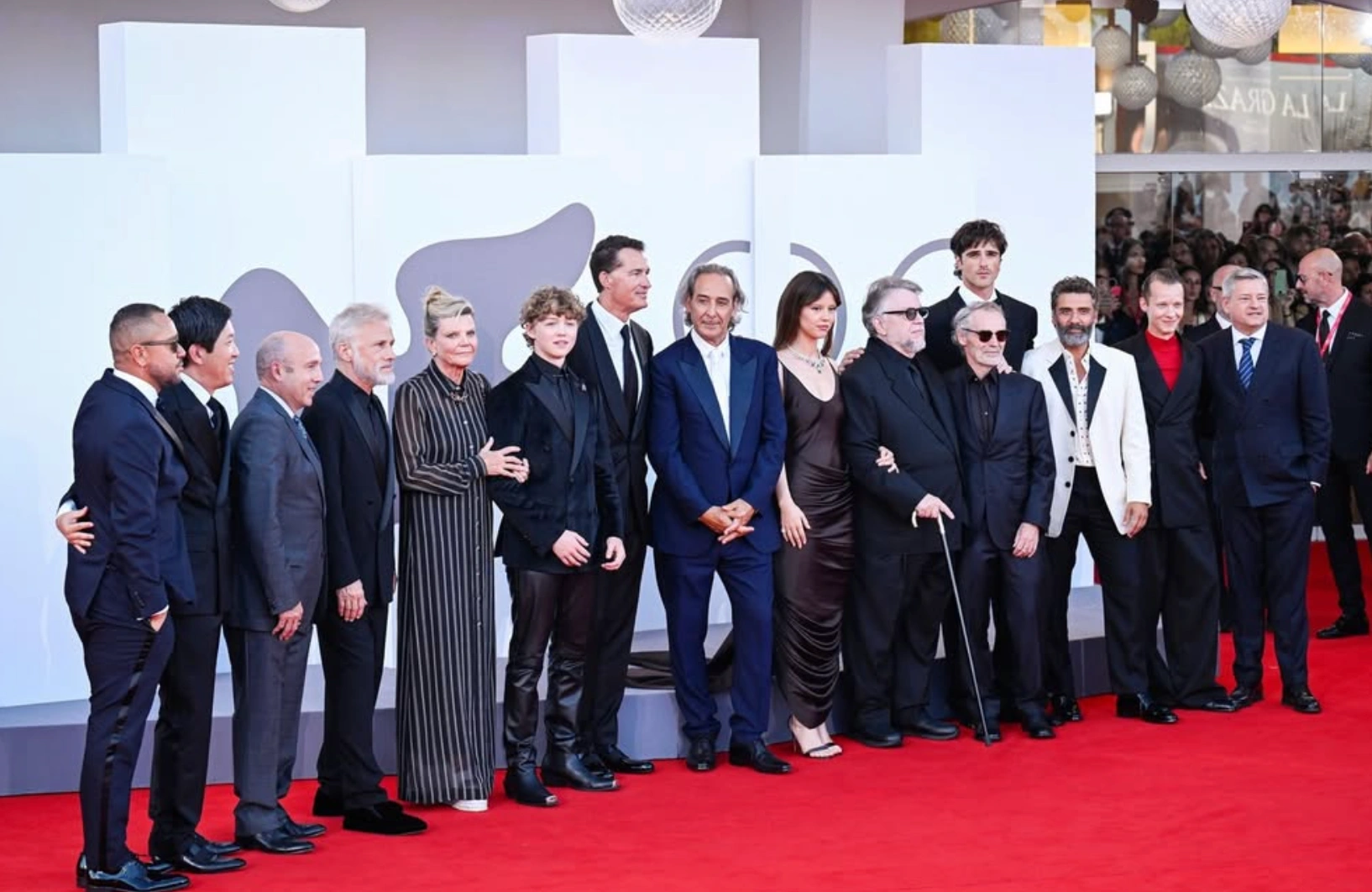Frankenstein's Journey: From Venice Ovation to Netflix Premiere

TL;DR
"Frankenstein" (2025) Marketing Strategy
Guillermo del Toro’s Frankenstein is being marketed as a humanist gothic drama. The campaign emphasizes auteur branding, painterly visuals, and a two-phase distribution strategy. This involves building credibility in theaters before transitioning to Netflix streaming. Dates, stills, and credits are centralized for global teams and press. The limited theatrical run followed by the Netflix release signals a prestige play designed for mass consumption on the platform.
- Prestige first, conversion second: limited theatrical in October and November, Netflix streaming started on November 7, 2025.
- Festival placement supplies critic capsules and red-carpet imagery that later appear as on-screen supers.
- Social plan blends mystery reveals with craft explainers; creator kits keep posts on-code.
Campaign Thesis and Release Plan
The marketing plan frames Guillermo del Toro as a trust mark. It uses painterly visuals and times a short theatrical release before a Netflix debut. This ensures that curiosity built in cinemas converts at home. Dates, stills, and credits are centralized. Trade reporting outlines the limited theatrical window followed by the Netflix drop.
- Prestige first, conversion second; empathy and consequence are the public narrative.
- One canonical asset hub keeps language and visuals consistent across markets.
Image Credit: Netflix
Teaser and Trailer Cadence
The teaser sells tone and silhouette while withholding the Creature. The full trailer escalates character stakes without plot dumps. It leans on practical texture, long takes, and a melancholy score. Official uploads make the workflow easy: date card, credits, and thumbnail variants packaged for global reuse (Netflix YouTube) with matching summaries and stills on the editorial hub.
- Editorial rule: open on a recognisable del Toro visual, close on a quotable line.
- Distribution rule: social cuts at 6–10 seconds, pre-roll at 15–30, all landing on the Netflix date.
Festival Positioning and Social Proof
Festival placement creates a bank of critic capsules, ovation anecdotes, and red-carpet imagery. Coverage framed Frankenstein as an auteur event (Variety). Those early reactions feed upper-funnel media and give social editors credible copy lines before paid countdowns begin.
- Use critic pull-quotes as supers in YouTube/OTT edits to “receipt” the promise (Variety).
- PR rhythm: festival reactions first, then cast Q&As that stress human stakes (Deadline).
-1.webp)
Limited Theatrical into Netflix
A brief theatrical window manufactures FOMO and generates premium stills. The near-term Netflix date then turns built intent into starts and watchlists. Trades have detailed this pattern for Netflix prestige titles (The Hollywood Reporter).
- Media handoff: prestige placements pre-streaming, then high-frequency “watch tonight” spots.
- KPI handoff: sentiment and reviews in theaters, completions and Day-1 starts on streaming.

Image Credit: netflixfilm
Director as Brand Code
Marketing leans into “director as brand,” treating Guillermo del Toro’s name, craft talk, and visual grammar as a recognition system. Interviews and features highlight his humanist lens and practical effects.
- Positioning line: a story about creation and responsibility, not a monster rampage.
- Consistency rule: composition, color, and type lock across all key art for instant attribution.
.webp)
Talent-Led Narrative and Human Stakes
Cast profiles frame the story through relationships, loneliness, and consequence. Long-form interviews become short, captioned verticals for international rollout.
- Clip kit: 20–40 second verticals with burned-in captions and clean end-cards (The Hollywood Reporter).
- Quote strategy: two empathy-forward lines per principal for press cards and thumbnails.
Image Credit: Netflix
Visual Identity and Sonic Codes
Key art favors silhouette and shadow. Title cards repeat a single typographic system, and a short musical tag threads through teaser, trailer, and cutdowns. Still galleries and poster variants are mirrored on the editorial hub (Netflix Tudum).
- House style: one grade, one type system, one end-card composition reused everywhere.
- Hygiene: daily share-card refresh and link checks to avoid mismatches in social previews.
Craft-Forward Content
Behind-the-scenes pieces on prosthetics, miniatures, costume patina, and sound layering create spoiler-safe posts. Featurettes and sanctioned stills give editors texture between the teaser and launch.
- Content beats: “creation files” shorts on makeup, sets, and score that can run daily.
- Platform split: timelapses for TikTok, longer breakdowns for YouTube featurettes.
Social Programming and Creator Collaborations
The social calendar blends mystery reveals with craft explainers. Creator partners receive a kit with end-cards, transitions, and the sonic tag. Centralized assets keep captions, credits, and regional titles consistent.
- Rule of two: every post should carry two brand codes, for example sonic tag plus title frame.
- Cadence: a seven-day countdown with platform-native CTAs and date stamps.
Performance Layer for Conversion Week
Five days out, creative pivots from mood to momentum. Talent voice over states when and where to watch, on-screen copy carries “Nov 7 on Netflix,” and media buys bias to home-page rails and OTT units.
- Metrics: watchlist adds, trailer completions, Day-1 starts, Day-2 retention.
- Retargeting: trailer engagers and festival-article readers with “it’s live” cutdowns.
Image Credit: Netflix
SWOT Analysis
Strengths: auteur equity, disciplined visual codes, festival lift, tight windowing. Weaknesses: restraint may undersell intensity for mainstream horror seekers. Opportunities: awards-season narratives and maker-community reels. Threats: discourse that fixates on monster canon over the film’s humanist intent.
- Contingency: hold two harder-hitting spots for late-stage promo if sentiment skews “too quiet.”
- Extension: schedule a “making of the Creature” mini-doc in week two to deepen the long tail.
.webp)
Netflix Activation Events
Netflix coordinated a series of events in the Hollywood area that involved drones and a simulated lightning strike. This led up to a sold-out IMAX screening of the new Frankenstein at the TCL Chinese Theater. Jason Reitman chatted with Guillermo del Toro after the film. Oscar Isaac, Jacob Elordi, Mia Goth and Christoph Waltz star in the feature.
- The celebration began with a 1,500-drone lightning storm above the Hollywood Forever Cemetery.
- Six coordinated drone shows blended with technology to simulate a lightning storm above the Hotel Roosevelt and Capitol Records building in Hollywood.
- The Frankenstein celebration also spread to New York City.
Venice Film Festival Ovation
Guillermo Del Toro’s Frankenstein received a 15-minute ovation at the Venice Film Festival. Oscar Isaac stars as Dr. Victor Frankenstein, and Jacob Elordi plays the creature.
- Del Toro won the festival’s top prize with 2017’s The Shape of Water.
- Netflix will release Frankenstein in November.

Brand-Building vs. World-Building
Brand-building makes people recognize you; world-building gives you more places to meet them.
- Anchor for fast recognition; expand the world to unlock new reach and frequency.
- Go wide to plant memory, then go deep so more impressions convert with less effort.
Core Idea: Anchor, Then Universe
Pick one anchor: tagline, sonic cue, mascot, or signature pack/shape. Build a simple universe around it. This includes three go-to locations, two recurring characters, and one ritual.
- Guardrail: change chapters, not codes- variety for reach, consistency for attribution.
- Practice: show a core asset in the first frame; close with a consistent end card.
Brand-Building for Instant Recognition
Bake recognizable assets into the opening beat. Give the brand a visible role in the action, and repeat a locked end frame for “memory closure.” Creative quality lifts both paid efficiency and organic carryover (Nielsen: Creative impact).
- Rule of two: two brand cues in the first five seconds; repeat one at the end.
- Toolkit: hero line, sonic sting, framing rules, colour system, pack timing.
-1.webp)
World-Building for Depth
Define a “canon” (places, characters, props, tone) and release chapters that map to real use situations. Because scenes are modular and on-code, you can ship more formats, more often, across more channels and creators.
- World bible essentials: three locales, two characters, one recurring ritual, plus do/don’t examples.
- Chapter plan: quarterly arcs tied to seasonality, launches, or cultural moments.
Wide, Then Deep: Sequencing
Plant the anchor with broad, emotion-led reach so people learn your code. Then feed depth with short, episodic pieces that keep frequency high without creative fatigue. Long-term brand-building grows tomorrow’s demand; short-term activation harvests today’s (IPA: Binet & Field).
- Flighting mix: hero film for fame; short cuts for frequency; OOH/audio to reinforce cues.
- Edit check: no cue, no media- every cut must contain at least one distinctive asset.
.webp)
Map Entry Moments
List the situations that precede choice: post-workout, Friday treat, team quick win. Build scenes that literally name or depict those moments. Each new moment you claim opens a fresh vein of reach.
- Playbook: pick 5–8 entry moments for the next 12 months; ship one clean execution per moment.
- Language tip: say the moment in copy or show it plainly on screen to “teach” recall.
Balance Brand and Performance
Run brand and performance together. Keep the same anchor and world cues inside your direct-response units so every cheap click also builds memory. Set separate budgets and KPIs (IPA: Effectiveness).
- Starting point to test: 60/40 brand/performance, then tune to your category.
- DR rule: same device, same sonic, same pack, new offer, faster path.
Creators as Reach Multipliers
Give creators rails: editable end cards, motion presets, a “scene grammar” so their content stays in-world. Hold submissions to a simple test: can a viewer recognise the brand in three seconds? (Nielsen: Creative impact).
- Provide: asset files, transitions, caption styles, and a short do/don’t reel.
- Greenlight rule: no clear cue in the opening beats, no publish.
Product as Plot
Make products act in-world. Assign roles (solver, treat, pro option) and show them changing outcomes. Using a simple beat—problem → brand action → better result—lets you spin countless platform-specific edits.
- Beat list to reuse: same action across locales; same cue across formats.
- Always-on: keep one evergreen scene per entry moment you can rotate year-round.
UX as Canon
Mirror the ad’s headline and hero on the landing page. Give one obvious next step, and make mobile paths wallet-ready (Think with Google: Micro-moments).
- First-viewport rule: same hook, same hero, one clear action, no generic homepages.
- Friction check: measure page speed and form steps like they’re media metrics.
Measurement
Track two stacks. Salience: asset recognition, two-second attribution, prompted/unprompted recall. Depth and scale: repeat engagement, time in-world, creator/UGC lifts, and cost-per-incremental-reach (Ehrenberg-Bass: Distinctive assets).
- Quarterly “asset fluency” test; fix or bin low-coding edits early.
- Episode scorecard: does it expand the world and lower cost-per-effective-reach?
Governance
Write a concise world guide: anchor, assets, characters, locales, tone, motion, type, dos/don’ts- and attach it to every brief (IPA: Binet & Field).
- Greenlight mantra: no anchor, no media; consistency is how scale stays efficient.
- Drift watch: standardise pre-flight checks on colour, sonic, and framing.
.webp)






